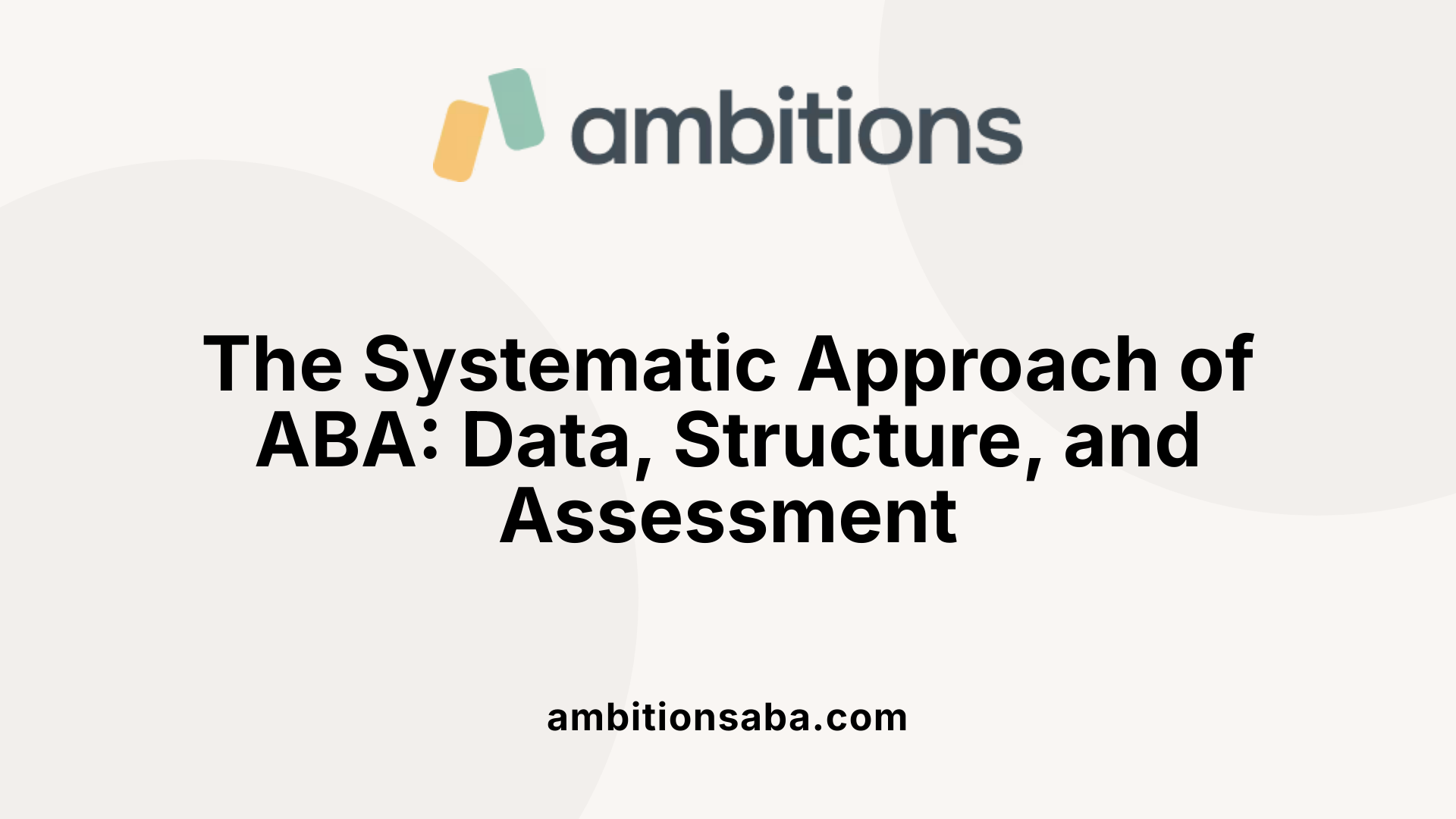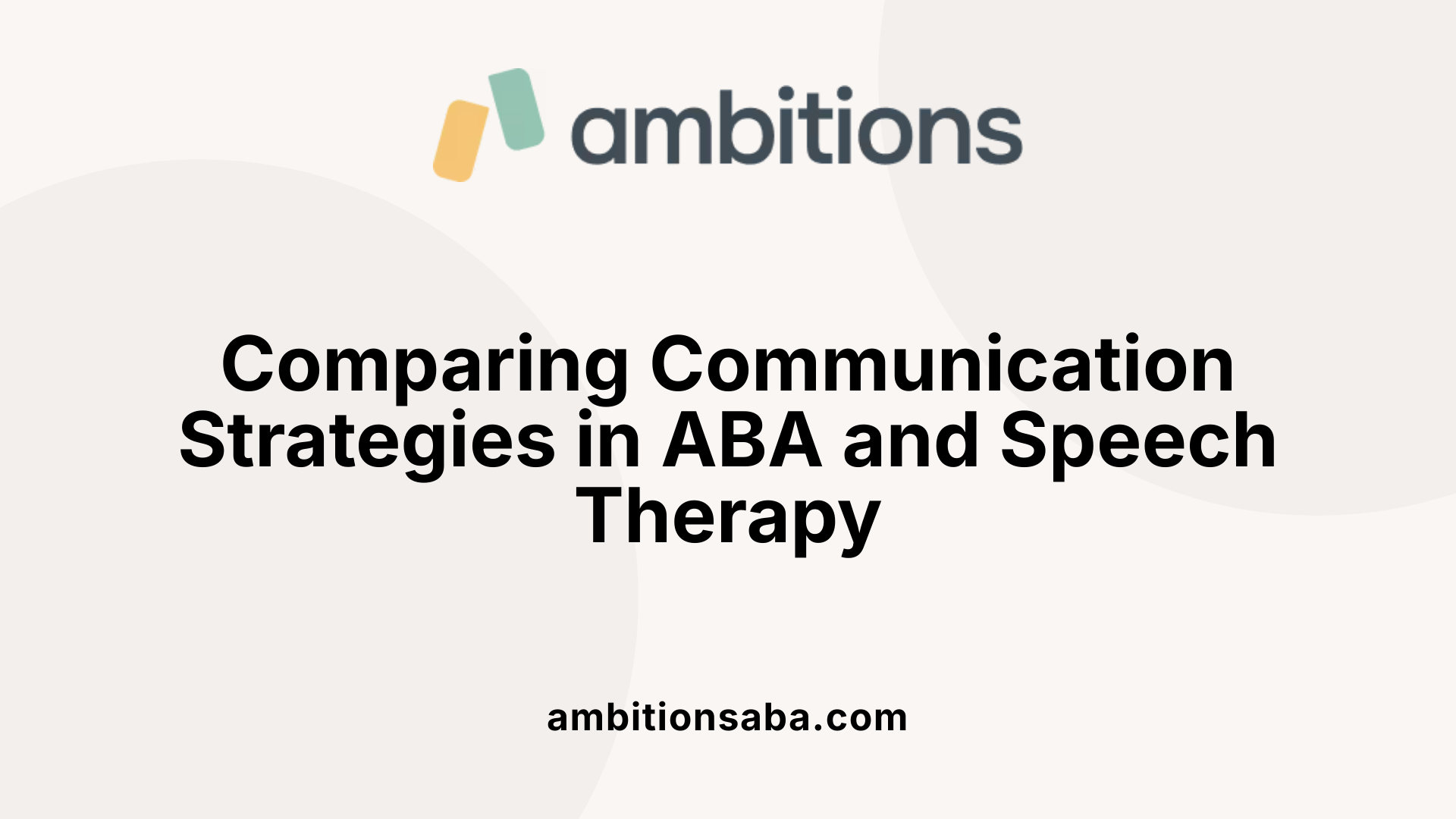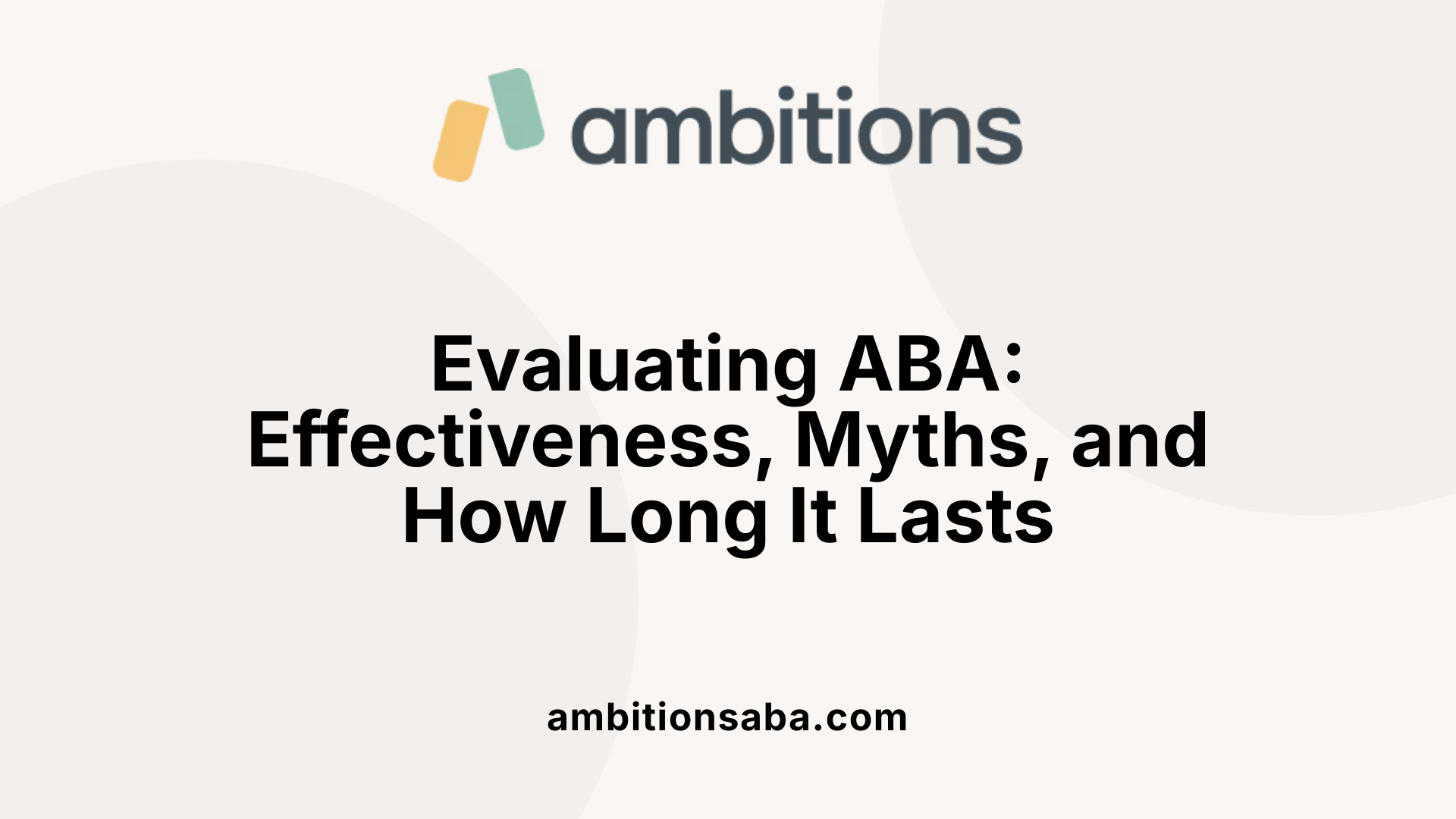Clarifying Behavioral Therapies and Their Applications
Behavioral therapies encompass a diverse array of techniques designed to modify maladaptive behaviors across numerous psychological conditions. Among these, Applied Behavior Analysis (ABA) stands out as a specialized, research-driven therapy primarily tailored for individuals with autism spectrum disorder. This article explores how ABA differs from other behavioral therapies in methodology, scope, and application, clarifying its distinctive approach and benefits in treating autism.
Foundations and Scope of Behavioral Therapies versus ABA

What is Behavioral Therapy and How Does It Differ from ABA?
Behavioral therapy is a broad category of therapeutic approaches centered on modifying observable maladaptive behaviors. It addresses a variety of psychological issues such as anxiety, depression, and PTSD, providing flexible and often less structured interventions tailored to individual needs. In contrast, Applied Behavior Analysis (ABA) is a highly structured, data-driven form of behavioral therapy primarily designed for individuals with autism and other developmental disorders. ABA focuses on analyzing and changing behavior through specific techniques and clearly defined goals.
Scope and Application of Behavioral Therapy Compared to ABA
While behavioral therapy covers a wide range of psychological problems and employs a diverse set of approaches, ABA’s scope is more specialized and intensive. ABA targets skill development in areas like communication, social interaction, and academic skills, as well as reducing challenging behaviors in children with autism. It relies on systematic assessments and individualized treatment plans developed by Board Certified Behavior Analysts (BCBAs). Behavioral therapy, by contrast, is less narrowly defined and used across broader mental health concerns.
Who Are the Target Populations?
Behavioral therapy serves a diverse population with various psychological disorders, including anxiety and depression. On the other hand, ABA therapy is predominantly aimed at children with autism spectrum disorder and developmental delays. Its methods are specifically tailored to improve socially significant behaviors and support skill acquisition necessary for effective functioning within daily life.
How Does ABA Therapy Help Individuals with Autism?
ABA therapy utilizes scientifically validated methods based on learning principles to encourage positive behaviors and decrease harmful ones. It involves teaching communication and social skills through structured techniques like Discrete Trial Training and functional communication training, often incorporating naturalistic strategies such as Pivotal Response Treatment. By breaking complex behaviors, including language, into manageable components, ABA facilitates language development and socialization. The therapy is evidence-based, individualized, and adaptable to settings like home, school, and community, leading to measurable improvements in quality of life for individuals with autism.
Methodology and Structure: ABA's Highly Systematic Approach

What is the structure of ABA therapy?
ABA therapy is characterized by a highly structured and systematic approach. It starts with a thorough assessment by a Board Certified Behavior Analyst (BCBA) to develop an individualized treatment plan tailored to the child's needs. The program sets clear, measurable goals related to communication, social skills, academic abilities, and behavior reduction.
One hallmark of ABA is Discrete Trial Training (DTT), a method involving one-on-one teaching sessions with clear prompts and reinforcement to shape behaviors. Other methods include Pivotal Response Treatment (PRT), which is more play-based and uses the child's interests as natural motivators, and the Early Start Denver Model (ESDM) that combines play activities with ABA techniques targeting various developmental areas.
How does ABA use data and assessments?
Data collection is central to ABA, ensuring continuous evaluation of progress. Therapists closely monitor behaviors and skills, using data to adapt the treatment plan for maximum effectiveness. This data-driven process supports decision-making and helps identify which interventions successfully increase positive behaviors and decrease maladaptive ones.
How does behavioral therapy differ in flexibility and techniques?
Unlike ABA's structured model, broader behavioral therapy often offers more flexibility and variety in techniques. It encompasses a range of approaches aimed at modifying observable behaviors and can be adapted to treat diverse psychological issues such as anxiety, depression, and PTSD. This flexibility allows therapists to tailor interventions according to individual client needs with varying levels of structure, compared to the more regimented ABA framework focused primarily on developmental disorders like autism.
Individualized Goals and Targeted Outcomes in ABA

How Are Goals Set in ABA Therapy?
ABA therapy begins with a thorough assessment conducted by a Board Certified Behavior Analyst (BCBA). This evaluation helps develop an individualized treatment plan tailored specifically to each child's unique needs. The goals are concrete and measurable, focusing on improving socially significant behaviors.
What Skill Areas Does ABA Address?
ABA programs typically address several important areas including communication, social interactions, academic performance, and behavior management. For example, communication goals may target language skills like requesting (manding) or labeling (tacting). Social skills focus on appropriate interactions and joint attention. Behaviors that interfere with learning or social inclusion are also addressed to reduce their frequency.
How Do ABA Goals Compare to Those in Broader Behavioral Therapy?
While behavioral therapy encompasses a wider range of psychological issues such as anxiety or depression, ABA’s goal-setting is more specialized toward developmental disorders like autism. Behavioral therapy may have broad aims like reducing anxiety or depression symptoms. In contrast, ABA sets specific, skill-based outcomes to increase functional communication and social skills, often using structured, data-driven methods.
This individualized and targeted approach helps ABA therapy to effectively build meaningful skills and reduce challenging behaviors uniquely suited to each child.
Techniques Unique to ABA and Their Role in Autism Treatment

What Is Discrete Trial Training (DTT)?
Discrete Trial Training is a hallmark technique of ABA therapy characterized by its highly structured and systematic approach. Conducted usually in one-on-one sessions, DTT breaks down complex skills into small, teachable components. Each "trial" consists of a clear instruction, a response from the child, and immediate feedback or reinforcement to shape behavior. This method no longer involves punishment but focuses on positive reinforcement to encourage skill acquisition.
How Does Functional Communication Training Work?
Functional Communication Training (FCT) is designed to improve communication by teaching alternative, effective ways to express needs and desires, reducing problematic behaviors that arise from communication difficulties. By focusing on teaching meaningful verbal and non-verbal communication strategies, FCT supports children in building practical language skills vital for daily interactions.
What Are Play-Based ABA Methods Like PRT and ESDM?
Play-based approaches within ABA such as Pivotal Response Treatment (PRT) and the Early Start Denver Model (ESDM) introduce less structured, naturalistic learning. PRT capitalizes on a child's interests and uses natural reinforcement to motivate learning, making sessions feel more like play than formal teaching. ESDM integrates play with traditional ABA techniques, targeting multiple developmental areas simultaneously, and is tailored especially for very young children.
How Do These ABA Techniques Compare with Broader Behavioral Therapy?
Unlike broader behavioral therapy, which can be more flexible and less structured across a wide range of psychological concerns, ABA is highly data-driven and specific to autism and developmental disorders. ABA focuses intensely on measurable outcomes and individual goals such as communication, social skills, and behavior reduction. While broader behavioral therapy addresses a variety of issues and might use generalized behavioral modification strategies, ABA’s specialized techniques like DTT, FCT, PRT, and ESDM offer a detailed, targeted toolkit designed to enhance socially significant skills in children with autism.
ABA versus Speech Therapy: Overlaps and Differences

How ABA addresses communication
Applied Behavior Analysis (ABA) therapy treats all human actions, including language, as behavior. ABA breaks down language into four main verbal operants: Mand (requests), Tact (labels), Intraverbal (conversational responses), and Echoic (repeating). Through techniques like Discrete Trial Training, Functional Communication Training, Incidental Teaching, and joint attention activities, ABA helps children with autism develop essential communication and language skills. The therapy is highly structured and data-driven, focusing on reinforcing positive behaviors and shaping communication abilities.
Speech therapy goals and approaches
Speech therapy aims to improve both verbal and nonverbal communication. It supports children with autism by addressing language deficits and promoting meaningful interactions. Approaches include articulation therapy, oral motor exercises, and the use of augmentative and alternative communication (AAC) devices. Over time, speech therapy has incorporated behavioral methods and enhances communication in natural contexts, helping children gain functional language skills.
Shared techniques and therapy duration
Both ABA and speech therapy employ overlapping techniques such as Functional Communication Training and Incidental Teaching, emphasizing naturalistic learning. However, ABA therapy tends to be more intensive, typically lasting one to three years with sessions around 3–4 hours per week. Speech therapy is generally shorter, usually 1–2 hours per week. Success in both therapies also relies heavily on parental involvement and consistency at home.
Effectiveness, Misconceptions, and Duration of ABA Therapy

Research-backed outcomes of ABA
Applied Behavior Analysis (ABA) has a strong foundation in research demonstrating its effectiveness for individuals with autism and developmental disorders. Studies reveal that ABA significantly improves socialization, communication, and expressive language skills. Early intensive ABA therapy, especially when conducted more than 20 hours per week during early childhood, can result in substantial developmental gains. These improvements often reduce the need for later special services, highlighting the importance of early intervention.
ABA interventions focus on increasing positive behaviors, such as communication and social skills, while decreasing negative or challenging behaviors. Methods such as reinforcement and shaping are commonly used to enhance language development, including requesting and labeling, which are essential for functional communication.
Common misconceptions about ABA
Despite its proven benefits, ABA therapy sometimes faces criticism and misunderstandings. One misconception is that ABA attempts to forcibly normalize children or use animal training methods. In reality, ABA emphasizes socially significant behaviors and employs positive reinforcement rather than punishment. It does not rely on bribery but encourages functional behavioral improvements through carefully designed, ethical techniques.
Another false impression is that ABA focuses only on reducing problematic behaviors. However, the therapy equally prioritizes skill acquisition in areas like communication and social interaction. It is also personalized to each individual, respecting their unique needs and abilities.
Typical therapy duration and parental involvement
The duration of ABA therapy varies widely depending on the child’s individual requirements and progress. On average, therapy lasts from one to three years, typically involving 3 to 4 hours of therapy per week. Continuous assessments by Board Certified Behavior Analysts (BCBAs) help tailor the treatment plan and guide the length of therapy.
Parental involvement plays a crucial role in ABA’s success. Families often learn and implement strategies at home, which helps reinforce skills learned during therapy sessions. This collaborative approach ensures that improvements are consistent and generalize across settings.
| Aspect | Details | Notes |
|---|---|---|
| Effectiveness | Improves social and communication skills; supported by research | Early intervention boosts outcomes |
| Misconceptions | Does not forcibly normalize or use punishment | Focuses on positive social behavior |
| Duration | 1-3 years at 3-4 hours/week | Tailored and adjusted with ongoing assessment |
| Parental Role | Key in reinforcing skills | Enhances therapy impact |
Summarizing the Distinctions and Strengths of ABA Therapy
While behavioral therapies in general offer flexible approaches to modifying a range of psychological and behavioral challenges, Applied Behavior Analysis (ABA) delivers a uniquely structured, evidence-based method tailored predominantly for individuals with autism. Its focus on data-driven, individualized programming and techniques specifically designed to enhance socially significant behaviors sets it apart. ABA's demonstrated effectiveness, combined with its adaptability to different settings and ages, underscores its prominence in autism treatment. Understanding these distinctions helps caregivers and professionals make informed decisions about appropriate therapeutic interventions.
References
- Behavioral Therapy vs ABA: Key Differences Explained
- ABA Therapy vs Speech Therapy for ASD: Which is Better ...
- Applied Behavior Analysis (ABA)
- Applied Behavior Analysis (ABA)
- The Top 10 Reasons Children With Autism Deserve ABA
- Applied Behavior Analysis (ABA)
- 6 Benefits of ABA Therapy for Children with Autism



